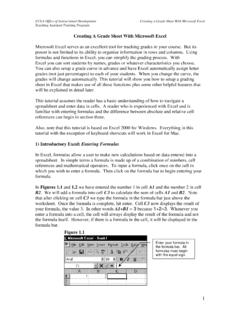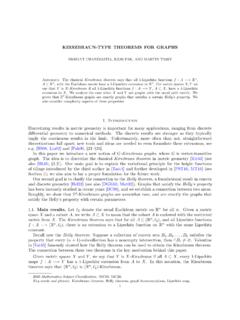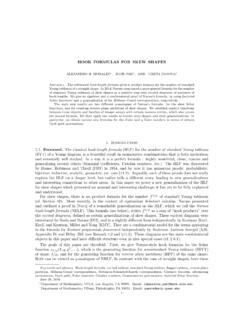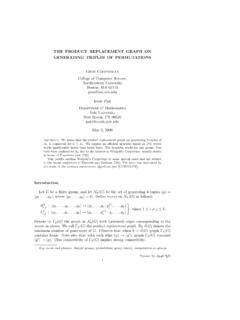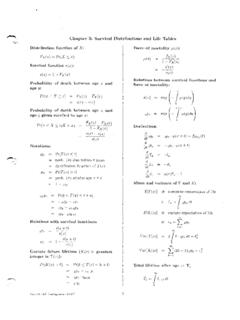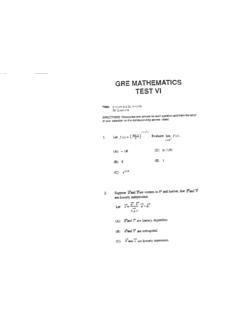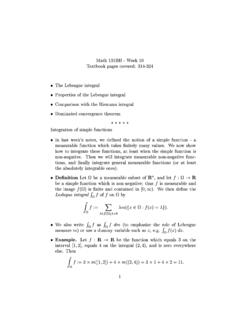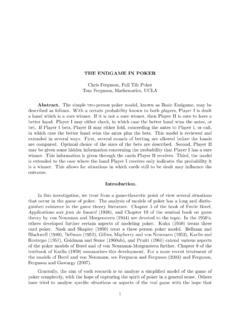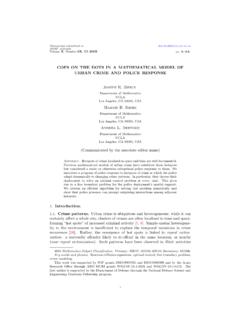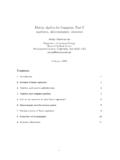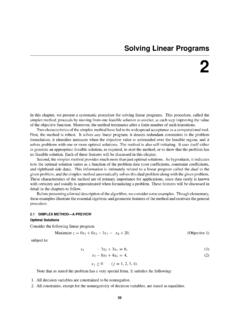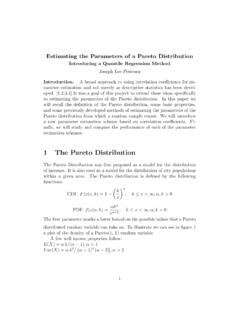Transcription of Linear algebra linear transformations transformation linear
1 Math 115A - Week 1 Textbook sections: covered: What is Linear algebra ? Overview of course What is a vector? What is a vector space? Examples of vector spaces Vector subspaces Span, Linear dependence, Linear independence Systems of Linear equations Bases* * * * *Overview of course This course is an introduction toLinear algebra . Linear algebra is thestudy oflinear transformationsand their algebraic properties. Atransformationis any operation that transforms an input to an out-put. A transformation islinearif (a) every amplification of the inputcauses a corresponding amplification of the output ( doubling of theinput causes a doubling of the output), and (b) adding inputs togetherleads to adding of their respective outputs. [We ll be more preciseabout this much later in the course.] A simple example of a Linear transformation is the mapy:= 3x, wherethe inputxis a real number, and the outputyis also a real , for instance, in this example an input of 5 units causes an outputof 15 units.
2 Note that a doubling of the input causes a doubling of theoutput, and if one adds two inputs together ( add a 3-unit inputwith a 5-unit input to form a 8-unit input) then the respective outputs1(9-unit and 15-unit outputs, in this example) also add together (to forma 24-unit output). Note also that the graph of this Linear transformationis a straight line (which is where the termlinearcomes from). (Footnote: I use the symbol := to mean is defined as , as opposed tothe symbol =, which means is equal to . (It s similar to the distinctionbetween the symbols = and == in computer languages such asC+ +,or the distinction between causation and correlation). In many textsone does not make this distinction, and uses the symbol = to denoteboth. In practice, the distinction is too fine to be really important, soyou can ignore the colons and read := as = if you want.) An example of anon-lineartransformation is the mapy:=x2; notenow that doubling the input leads to quadrupling the output.
3 Also ifone adds two inputs together, their outputs do not add ( a 3-unitinput has a 9-unit output, and a 5-unit input has a 25-unit output, buta combined 3 + 5-unit input does not have a 9 + 25 = 34-unit output,but rather a 64-unit output!). Note the graph of this transformation isvery much non- Linear . In real life, most transformations are non- Linear ; however, they can of-ten beapproximatedaccurately by a Linear transformation . (Indeed,this is the whole point of differential calculus - one takes a non-linearfunction and approximates it by a tangent line, which is a Linear func-tion). This is advantageous because Linear transformations are mucheasier to study than non- Linear transformations . In the examples given above, both the input and output werescalarquantities - they were described by a single number. However in manysituations, the input or the output (or both) is not described by asingle number, but rather by several numbers; in which case the input(or output) is not ascalar, but instead avector.
4 [This is a slightoversimplification - more exotic examples of input and output are alsopossible when the transformation is non- Linear .] A simple example of a vector-valued Linear transformation is given byNewton s second lawF=ma, or equivalentlya= can view this law as a statement that a forceFapplied to anobject of massmcauses an accelerationa, equal toa:=F/m; thusFcan be viewed as an input andaas an output. BothFandaarevectors; if for instanceFis equal to 15 Newtons in the East directionplus 6 Newtons in the North direction ( := (15,6)N), and theobject has massm:= 3kg, then the resulting acceleration is the vectora= (5,2)m/s2( 5m/s2in the East direction plus 2m/s2in theNorth direction). Observe that even though the input and outputs are now vectors inthis example, this transformation is still Linear (as long as the massstays constant); doubling the input force still causes a doubling of theoutput acceleration, and adding two forces together results in addingthe two respective accelerations together.
5 One can write Newton s second law in co-ordinates. If we are in threedimensions, so thatF:= (Fx, Fy, Fz) anda:= (ax, ay, az), then the lawcan be written asFx=1max+ 0ay+ 0azFy= 0ax+1may+ 0azFz= 0ax+ 0ay+ Linear transformation is associated to thematrix 1m0 001m00 01m . Here is another example of a Linear transformation with vector inputsand vector outputs:y1= 3x1+ 5x2+ 7x3y2= 2x1+ 4x2+ 6x3;this Linear transformation corresponds to the matrix(3 5 72 4 6).3As it turns out, every Linear transformation corresponds to a matrix,although if one wants to split hairs the two concepts are not quite thesame thing. [ Linear transformations are to matrices as concepts are towords; different languages can encode the same concept using differentwords. We ll discuss Linear transformations and matrices much later inthe course.] Linear algebra is the study of thealgebraic propertiesof Linear trans-formations (and matrices).
6 Algebrais concerned with how to manip-ulate symbolic combinations of objects, and how to equate one suchcombination with another; how to simplify an expression such as(x 3)(x+ 5). In Linear algebra we shall manipulate not just scalars,but also vectors, vector spaces, matrices, and Linear manipulations will include familiar operations such as addition,multiplication, and reciprocal (multiplicative inverse), but also new op-erations such as span, dimension, transpose, determinant, trace, eigen-value, eigenvector, and characteristic polynomial. [ algebra is distinctfrom other branches of mathematics such ascombinatorics(which ismore concerned with counting objects than equating them) oranalysis(which is more concerned with estimating and approximating objects,and obtaining qualitative rather than quantitative properties).]* * * * *Overview of course Linear transformations and matrices are the focus of this course.
7 How-ever, before we study them, we first must study the more basic conceptsof vectors and vector spaces; this is what the first two weeks will cover.(You will have had some exposure to vectors in 32AB and 33A, butwe will need to review this material in more depth - in particular weconcentrate much more on concepts, theory and proofs than on com-putation). One of our main goals here is to understand how a small setof vectors (called abasis) can be used to describe all other vectors ina vector space (thus giving rise to aco-ordinate systemfor that vectorspace). In weeks 3-5, we will study Linear transformations and theirco-ordinaterepresentationin terms of matrices. We will study how to multiply two4transformations (or matrices), as well as the more difficult question ofhow to invert a transformation (or matrix). The material from weeks1-5 will then be tested in the midterm for the course. After the midterm, we will focus on matrices.
8 A general matrix or lineartransformation is difficult to visualize directly, however one can under-stand them much better if they can bediagonalized. This will force usto understand various statistics associated with a matrix, such as deter-minant, trace, characteristic polynomial, eigenvalues, and eigenvectors;this will occupy weeks 6-8. In the last three weeks we will studyinner product spaces, which area fancier version of vector spaces. (Vector spaces allow you to addand scalar multiply vectors; inner product spaces also allow you tocompute lengths, angles, and inner products). We then review theearlier material on bases using inner products, and begin the studyof how Linear transformations behave on inner product spaces. (Thisstudy will be continued in 115B). Much of the early material may seem familiar to you from previouscourses, but I definitely recommend that you still review it carefully, asthis will make the more difficult later material much easier to handle.
9 * * * * *What is a vector? What is a vector space? We now review what a vector is, and what a vector space is. First letus recall what ascalaris. Informally, ascalaris any quantity which can be described by a sin-gle number. An example is mass: an object has a mass ofm kgforsome real numberm. Other examples of scalar quantities from physicsinclude charge, density, speed, length, time, energy, temperature, vol-ume, and pressure. In finance, scalars would include money, interestrates, prices, and volume. (You can think up examples of scalars inchemistry, EE, mathematical biology, or many other fields). The set of all scalars is referred to as thefield of scalars; it is usuallyjustR, the field of real numbers, but occasionally one likes to work5with other fields such asC, the field of complex numbers, orQ, thefield of rational numbers. However in this course the field of scalars willalmost always beR.
10 (In the textbook the scalar field is often denotedF, just to keep aside the possibility that it might not be the realsR;but I will not bother trying to make this distinction.) Any two scalars can be added, subtracted, or multiplied together toform another scalar. Scalars obey various rules of algebra , for instancex+yis always equal toy+x, andx (y+z) is equal tox y+x z. Now we turn to vectors and vector spaces. Informally, a vector is anymember of a vector space; a vector space is any class of objects whichcan be added together, or multiplied with scalars. (A more popular,but less mathematically accurate, definition of a vector is any quantitywith both direction and magnitude. This is true for some commonkinds of vectors - most notably physical vectors - but is misleading orfalse for other kinds). As with scalars, vectors must obey certain rulesof algebra . Before we give the formal definition, let us first recall some familiarexamples.
